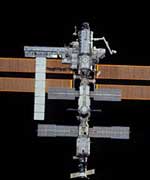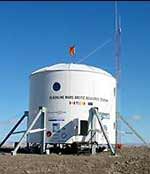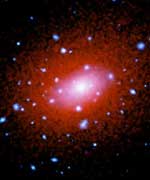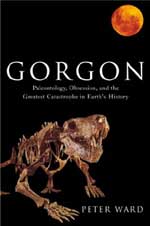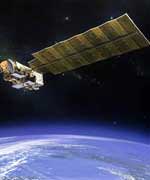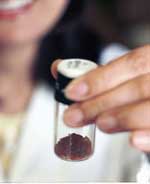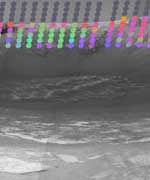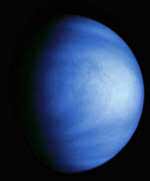
Image credit: NASA/JPL
On Tuesday 8 June, observers throughout Europe, as well as most of Asia and Africa, will be able to witness a very rare astronomical phenomenon when the planet Venus lines up directly between Earth and the Sun. Seen as a small black disk against the bright Sun, Venus will take about 6 hours to complete its crossing of the Sun’s face – known as a ‘transit’. The whole event is visible from the UK, weather permitting.
The last transit of Venus took place on 6 December 1882, but the last one that could have been seen in its entirety from the UK, as on this occasion, was in 1283 (when no one knew it was happening) and the next will not be until 2247! (The transit of 6 June 2012 will not be visible from the UK). The first transit of Venus to be observed was on 24 November 1639 (Julian Calendar). Transits also occurred in 1761, 1769 and 1874.
Venus and Mercury both orbit the Sun closer than Earth. Both planets regularly line up roughly between Earth and the Sun (called ‘conjunction’) but on most occasions they pass above or below the disc of the Sun from our point of view. Since 1631, transits of Venus have been occurring at intervals of 8, 121.5, 8 then 105.5 years and this pattern will continue until the year 2984. Transits of Mercury are more common; there are 13 or 14 each century, the next being in November 2006.
WHEN AND WHERE
The Venus transit of 8 June begins shortly after sunrise at about 6.20 BST, when the Sun will be about 12 degrees above the eastern horizon. It will take about 20 minutes from ‘first contact’ until the planet is fully silhouetted against the Sun, roughly at the ‘8 o’clock’ position’. It will then cut a diagonal path across the southern part of the Sun. Mid-transit is at about 9.22 BST. Venus begins to leave the Sun near the ‘5 o’clock’ position at about 12.04 BST and the transit will be completely over around 12.24. Timings differ by a few seconds for different latitudes, but clouds permitting, the transit will be visible from any place where the Sun is up, including the whole of the UK and almost all of Europe.
For a diagram of Venus’s track across the Sun, see:
http://sunearth.gsfc.nasa.gov/eclipse/OH/tran/Transit2004-2a.GIF (hi-res)
http://sunearth.gsfc.nasa.gov/eclipse/OH/tran/Transit2004-2b.GIF (low-res)
http://www.transit-of-venus.org.uk/transit.htm
For map showing where transit is visible, see:
http://sunearth.gsfc.nasa.gov/eclipse/OH/tran/Transit2004-1b.GIF
HOW TO VIEW
Venus is large enough to be just visible to someone with normal eyesight without the help of binoculars or a telescope. Its diameter will appear about 1/32 the diameter of the Sun. However, NO ONE SHOULD EVER LOOK DIRECTLY AT THE SUN, WITH OR WITHOUT A TELESCOPE OR BINOCULARS WITHOUT USING A SAFE SOLAR FILTER. TO DO SO IS VERY DANGEROUS AND IS LIKELY TO RESULT IN PERMANENT BLINDNESS.
For safe viewing of the transit, much the same rules apply as those for observing an eclipse of the Sun. Eclipse viewers can be used (as long as they are undamaged), and observing is limited to a few minutes at a time. (Note that they must NOT be used with binoculars or a telescope.) For an enlarged view, an image of the Sun can be projected onto a screen by a small telescope. Pinhole projection, however, will not produce a sharp enough image to show Venus clearly.
More detailed information on safety from:
http://sunearth.gsfc.nasa.gov/eclipse/SEhelp/safety2.html
http://www.transit-of-venus.org.uk/safety.htm
IMPORTANCE OF THE TRANSIT
In the 18th and 19th centuries, transits of Venus presented rare opportunities to tackle a fundamental problem – finding an accurate value for the distance between Earth and the Sun. The unit astronomers use for distance measurements in the solar system is based closely on its average value and is called the astronomical unit (AU). It is approximately 93 million miles, or 150 million km.
In the end, though observations of transits produced rough answers, they were never as accurate as originally hoped (see more on this below). But the quest was the stimulus for unprecedented international scientific cooperation and for expeditions that produced discoveries far beyond their original intended scope. Today, distances in the solar system are known with great precision through very different means.
In the 21st century, the main interest in the transits of Venus of 2004 and 2012 is their rarity as astronomical phenomena, the educational opportunities they present, and the sense of a link with important events in scientific and world history.
However, astronomers are now particularly interested in the general principle of planet transits as a way of hunting for extrasolar planetary systems. When a planet crosses in front of its parent star, there is a minute dip in the star’s apparent brightness. Identifying such dips will be a useful method of finding planets orbiting other stars. Some astronomers intend to use the transit of Venus as a test to help design searches for extrasolar planets.
The transit will be observed by two solar observatories in space: TRACE and SOHO. From where SOHO is positioned, it will not see a transit across the visible disc of the Sun, but it will observe Venus’s passage across the Sun’s corona (its outer atmosphere).
VENUS TRANSITS OF THE PAST
The first person to predict a transit of Venus was Johannes Kepler, who calculated that one would take place on 6 December 1631, just a month after a transit of Mercury on 7 November. Though the transit of Mercury was observed, the transit of Venus was not visible from Europe and there is no record of anyone seeing it. Kepler himself died in 1630.
Jeremiah Horrocks (also spelled Horrox), a young English astronomer, studied Kepler’s planetary tables and discovered with just a month to go that a transit of Venus would occur on 24 November 1639. Horrocks observed part of the transit from his home at Much Hoole, near Preston, Lancashire. His friend William Crabtree also saw it from Manchester, having been alerted by Horrocks. As far as is known, they were the only people to witness the transit. Tragically, Horrocks’s promising scientific career was cut short when he died in 1641, aged about 22.
Edmond Halley (of comet fame) realised that observations of transits of Venus could in principle be used to find how far the Sun is from Earth. This was a major problem in astronomy at the time. The method involved observing and timing a transit from widely spaced latitudes from where Venus’s track across the Sun would appear slightly different. Halley died in 1742, but the transits of 1761 and 1769 were observed from many places around the world. Captain James Cook’s expedition to Tahiti in 1769 is one of the most famous and went on to become a world voyage of discovery. However, results on the Sun-Earth distance were disappointing. The observations were plagued by many technical difficulties.
Nevertheless, 105 years later, optimistic astronomers tried again. The results were equally disappointing and people began to realise that the practical problems with Halley’s simple idea were just too great to overcome. Even so, by the 1882 tr ansit, there was enormous public interest and it was mentioned on the front page of most newspapers. Thousands of ordinary people saw it for themselves.
In his 1885 book, “The Story of Astronomy” Professor Sir Robert Stawell Ball described his own feelings on watching the transit 3 years earlier:
“… To have seen even a part of a transit of Venus is an event to remember for a lifetime, and we felt more delight than can be easily expressed… Before the phenomenon had ceased, I spared a few minutes from the somewhat mechanical work at the micrometer to take a view of the transit in the more picturesque form which the large field of the finder presents. The sun was already beginning to put on the ruddy hues of sunset, and there, far in on its face, was the sharp, round, black disk of Venus. It was then easy to sympathize with the supreme joy of Horrocks, when, in 1639, he for the first time witnessed this spectacle. The intrinsic interest of the phenomenon, its rarity, the fulfilment of the prediction, the noble problem which the transit of Venus helps us to solve, are all present to our thoughts when we look at this pleasing picture, a repetition of which will not occur again until the flowers are blooming in the June of A.D. 2004.”
For an excellent historical summary, see:
Venus Transit
THE FAMOUS ‘BLACK DROP’ PROBLEM
One of the chief problems visual observers of transits faced was pinpointing the exact time when Venus was first fully on the visible face of the Sun. Astronomers call this point ‘second contact’. In practice, as Venus crossed onto the Sun, its black disc seemed to remain linked to the edge of the Sun for a short time by a dark neck, making it appear almost pear-shaped. The same happened in reverse when Venus began to leave the Sun. This so-called ‘black drop effect’ was the main reasons why timing the transits failed to produce consistent accurate results for the Sun-Earth distance. Halley expected second contact could be timed to within about a second. The black drop reduced the accuracy of timing to more like a minute.
The black drop effect is often mistakenly attributed to Venus’s atmosphere but Glenn Schneider, Jay Pasachoff and Leon Golub showed last year that the problem is due to a combination of two effects. One is the image blurring that naturally takes place when a telescope is used (described technically as ‘the point spread function’). The other is the way the brightness of the Sun diminishes close to its visible ‘edge’ (known to astronomers as ‘limb darkening’).
More experiments will be done on this phenomenon at the 8 June transit of Venus using the TRACE solar observatory in space.
VENUS – THE PLANETARY EQUIVALENT TO HELL.
At first glance, if Earth had a twin, it would be Venus. The two planets are similar in size, mass and composition, and both reside in the inner part of the Solar System. Indeed, Venus comes closer to Earth than any of the other planets.
Before the advent of the Space Age, astronomers could only speculate over the nature of its hidden surface. Some thought that Venus might be a tropical paradise, covered in forests or oceans. Others believed that it was a totally barren, arid desert. After investigations by numerous American and Russian spacecraft, we now know that Earth’s planetary neighbour is the most hellish, hostile world imaginable. Any astronaut unlucky enough to land there would be simultaneously crushed, roasted, choked and dissolved.
Unlike Earth, Venus has no ocean, no satellites and no intrinsic magnetic field. It is covered by thick, yellowish clouds – made of sulphur and droplets of sulphuric acid – that act like a blanket to trap surface heat. The upper cloud layers move faster than hurricane-force winds on Earth, sweeping all the way around the planet in just four days. These clouds also reflect most of the incoming sunlight, helping Venus to outshine everything in the night sky (apart from the Moon). At the present time, Venus dominates the western sky after sunset.
Atmospheric pressure is 90 times that of Earth, so an astronaut standing on Venus would be crushed by pressure equivalent to that at a depth of 900 m (more than half a mile) in the Earth’s oceans. The dense atmosphere consists mainly of carbon dioxide (the greenhouse gas that we breathe out every time we exhale) and virtually no water vapour. Since the atmosphere allows the Sun’s heat in but does not allow it to escape, surface temperatures soar to more than 450 deg. C – hot enough to melt lead. Indeed, Venus is hotter than Mercury, the planet closest to the Sun.
Venus rotates sluggishly on its axis once every 243 Earth days, while it orbits the Sun every 225 days – so its day is longer than its year! Just as peculiar is its retrograde, or “backwards” rotation, which means that a Venusian would see the Sun rise in the west and set in the east.
Earth and Venus are similar in density and chemical composition, and both have relatively young surfaces, with Venus appearing to have been completely resurfaced 300 to 500 million years ago.
The surface of Venus comprises about 20 per cent lowland plains, 70 per cent rolling uplands, and 10 per cent highlands. Volcanic activity, impacts, and deformation of the crust have shaped the surface. More than 1,000 volcanoes larger than 20 km (12.5 mls) in diameter dot the surface of Venus. Although much of the surface is covered by vast lava flows, no direct evidence of active volcanoes has been found. Impact craters smaller than 2 km (1 ml) across do not exist on Venus because most meteorites burn up in the dense atmosphere before they can reach the surface.
Venus is drier than the driest desert on Earth. Despite the absence of rainfall, rivers or strong winds, some weathering and erosion does occur. The surface is brushed by gentle winds, no stronger than a few kilometres per hour, enough to move grains of sand, and radar images of the surface show wind streaks and sand dunes. In addition, the corrosive atmosphere probably chemically alters rocks.
Radar images sent back by orbiting spacecraft and ground-based telescopes have revealed several elevated “continents”. In the north is a region named Ishtar Terra, a high plateau larger than the continental United States and bounded by mountains almost twice as high as Everest. Near the equator, the Aphrodite Terra highlands, more than half the size of Africa, extend for almost 10,000 km (6,250 miles). Volcanic lava flows have also produced long, sinuous channels extending for hundreds of kilometres.
Original Source: RAS News Release
